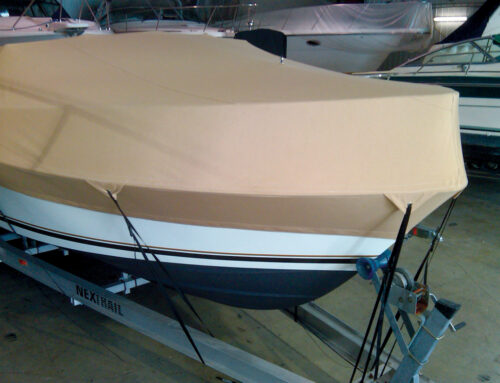Interiors present business opportunities
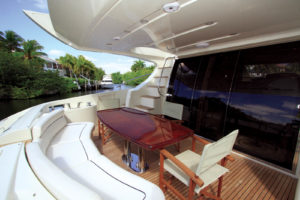
An investment in new canvas above and below deck is a cost-effective way for boat owner to have the feeling of a new boat at a fraction of the cost.
In today’s business climate, everyone is looking for growth opportunities, including marine fabricators who have felt the effects of consumers holding on to hard-earned cash. One of the most promising areas for profitable growth for marine fabricators is actually very close at hand.
“Any marine fabricator who is not doing cockpit and cabin up-fits is leaving cash on the table,” says Tom Koster, marine products manager for Tri Vantage, the nation’s largest distributor of marine fabrics and components. “Granted, biminis and cushions are very different products, but you use the same machines and the same skill sets for both. It’s more a matter of mindset than anything else.”
Skilled labor
The mindset among many marine fabricators is that cockpit and interior work is tedious, time consuming and not as profitable as exterior canvas. This conventional wisdom is being challenged everyday by fabricators such as Needle Loft in Kemah, Texas. Owned and operated by Linda Delgado for 32 years, this thriving enterprise has proven that interior work is profitable and a natural extension of work above deck.
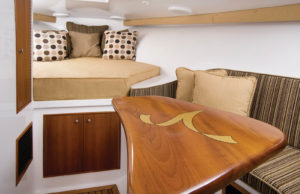
The mindset among many marine fabricators is that cockpit and interior work is tedious, time consuming and not as profitable as exterior canvas. But this conventional wisdom is being challenged everyday by successful fabricators across the country.
“As a registered interior designer, I do have an advantage in work below deck,” Delgado says. “To be successful with interiors, you have to take the time to listen to your customers and find just the right look for them. But it pays off. I have customers who have owned three and four boats over the years, and I’ve done work on all their boats, inside and out.”
According to Delgado, one of the major challenges is finding skilled labor. When she recruits an employee with solid sewing skills, good aptitude and attitude, she is willing to do on-the-job training.
“The Marine Fabricators Association (MFA), sectional groups and even community colleges offer courses that help get you started with interior work,” she says. “There are so many opportunities when you do boat interiors, including cushions, draperies, pillows, bedspreads and mattresses. Down here in Texas, we welcome the opportunity to get out of the sun and work on interiors during the hottest months.”
The right time
The seasonality of marine canvas is another reason that fabricators should consider diversifying their offerings. Spring and summer are typically boom times for marine fabricators with more work than there are hours in the day. Winter months are typically much slower, which could be an ideal time to make cushions, curtains and accessories in the warmth of a fabrication shop.
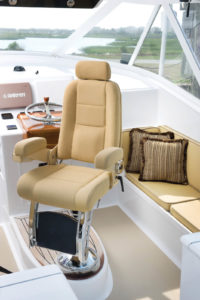 “During the height of the season, time is of the essence for marine fabricators,” Koster says. “You want to do the most work possible, and boat owners want the work completed as soon as possible so they can enjoy being on the water. In the off season, it is an entirely different story when marine fabricators may have time on their hands and when boaters are no longer using their boats every weekend.”
“During the height of the season, time is of the essence for marine fabricators,” Koster says. “You want to do the most work possible, and boat owners want the work completed as soon as possible so they can enjoy being on the water. In the off season, it is an entirely different story when marine fabricators may have time on their hands and when boaters are no longer using their boats every weekend.”
Jay Stroker, who was a marine fabricator for more than 20 years before joining Tri Vantage as a senior account representative, says cockpit and interior work requires that marine fabricators take a broader view of opportunities for profitable growth.
“We encourage marine fabricators to expand their horizons and recognize a broader diversity of opportunities within boating, from cruisers and run-abouts to sport fishers and yachts,” Stroker says. “The family yachting experience has really expanded in recent years with a great deal of emphasis on comfort below deck. Plush appointments, designer color schemes and comfortable sleeping all represent opportunities for marine fabrication.”
New materials
Marine fabricators who decide to take the leap into cockpit and cabin projects are assured of a wide assortment of materials for virtually every application and every pocketbook. Non-woven fabrics, such as vinyl and vinyl-like materials, come in a great diversity of colors, textures and performance characteristics. Non-woven fabrics range from the basic to offerings that have the look and feel of fine leather. UV and mildew resistance are engineered into most offerings, as is ease of sewing.
For boaters who want the look of home upholstery, there is a diverse offering of Sunbrella® performance fabrics for cockpits and below deck. The design and color of these fabrics have been inspired by home interiors, yet are influenced by the marine lifestyle. Durability, fade and mildew resistance and ease of cleaning continue in the Sunbrella performance tradition.
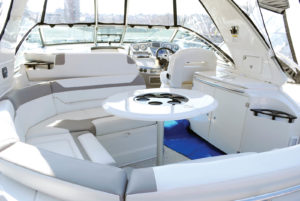
Marine fabricators who decide to take the leap into cockpit and cabin projects are assured of a wide assortment of materials for virtually every application and every pocketbook.
High performance, skid-resistant marine carpets are also available for a great diversity of needs, inside and out. Gas, oil and sun are no match for marine carpets, which are designed for easy installation. There are even marine carpets that mimic the look and feel of fine Berber carpets found in many homes today.
“We have wonderful materials to work with for boat interiors,” says Katie Bradford, owner of Custom Marine Canvas of Noank, Conn. “Not only has the Sunbrella line expanded, but Glen Raven licenses Sunbrella yarns to design houses that are creating extraordinary patterns. Nonwoven vinyl materials are also getting better all the time. There is constant development work in this area with new patterns and leather-like offerings.”
For Custom Marine Canvas, offering interior up-fits has been a substantial financial benefit given the effects of the economy on the marine industry. As boaters are keeping their vessels for longer periods of time before trading up, the ability of a marine fabricator to suggest up-fit opportunities has never been more important. An investment in new canvas above and below deck is a cost-effective way for a boat owner to have the feeling of a new boat at a fraction of the cost.
“We had a similar experience with the recession of the 1980s when people were holding on to their existing boats rather than buying new,” Bradford says. “We tell customers that for 10 percent of the cost of a new boat, we can give them new sails, completely new canvas and a new interior.”
Bradford says that interior work is not for all marine fabricators, but there are benefits of growth and stability for those who are willing and able to diversify.
“Interior work is a challenge, but we love to do it, and we’re good at it,” she says. “Accuracy, accuracy and accuracy are the secrets to success. If you are a meticulous craftsman, then you should be able to succeed with interiors work.”
Mark Brock is a writer, public relations consultant and boat owner who has been working in the marine industry for more than 20 years.
 TEXTILES.ORG
TEXTILES.ORG 




